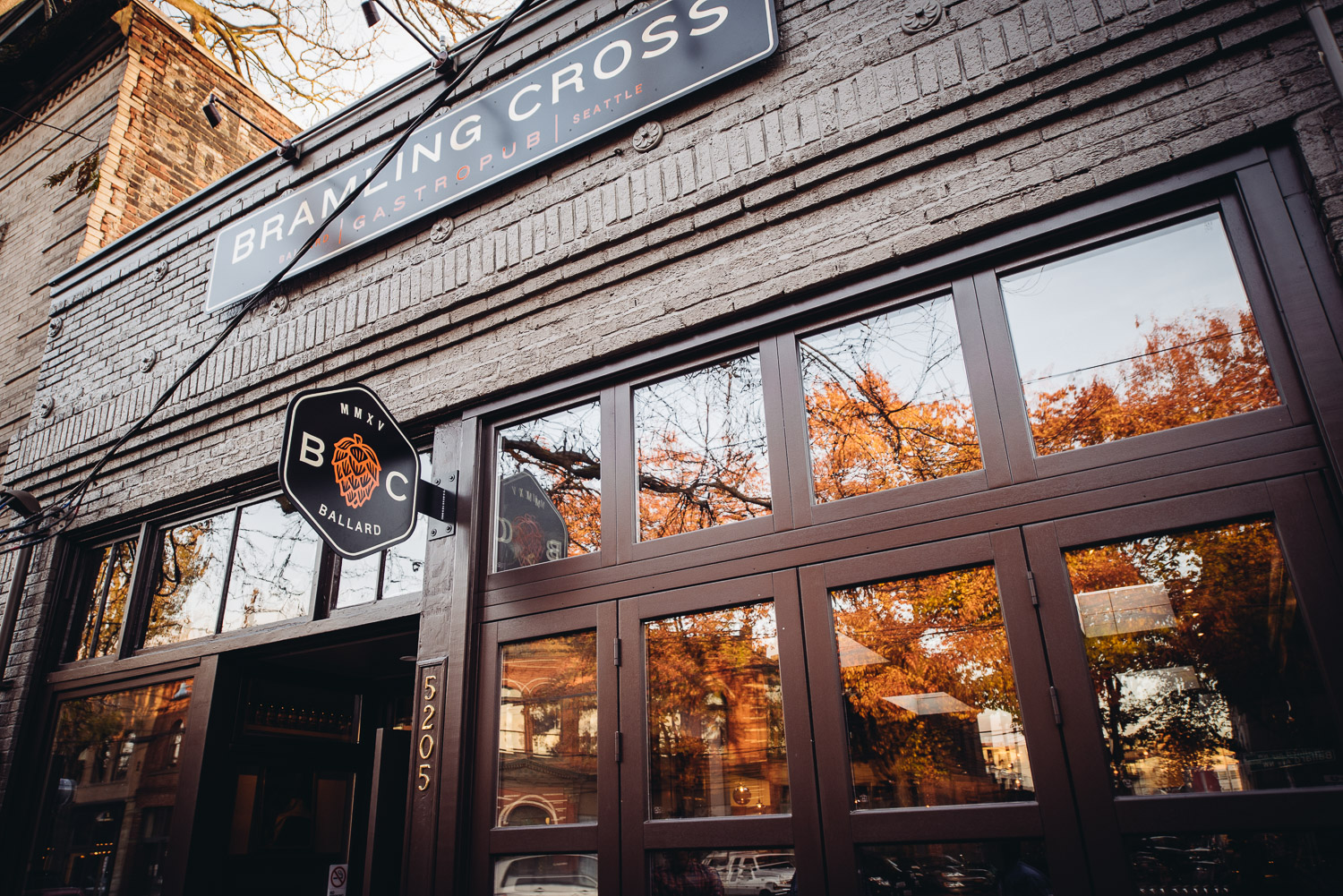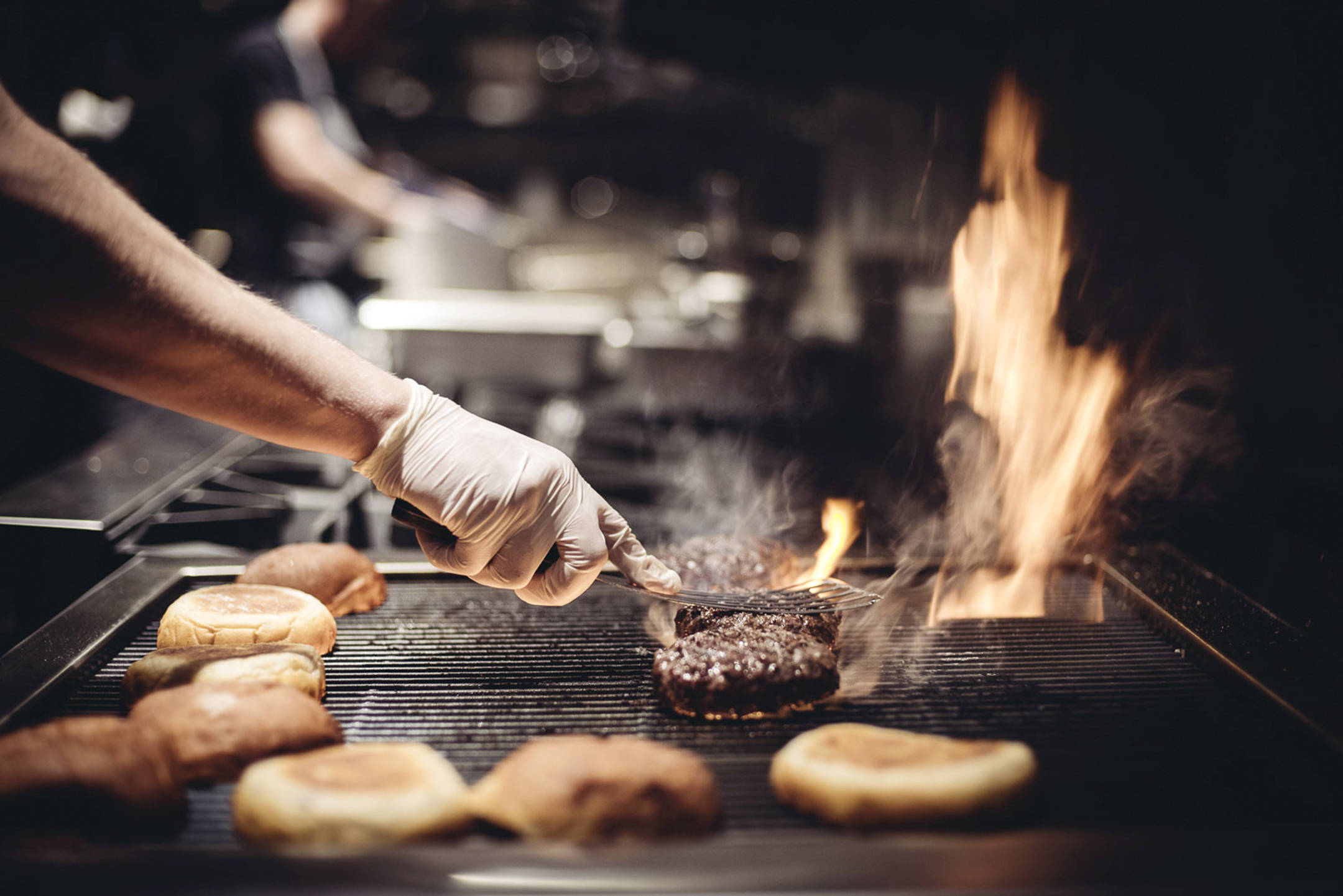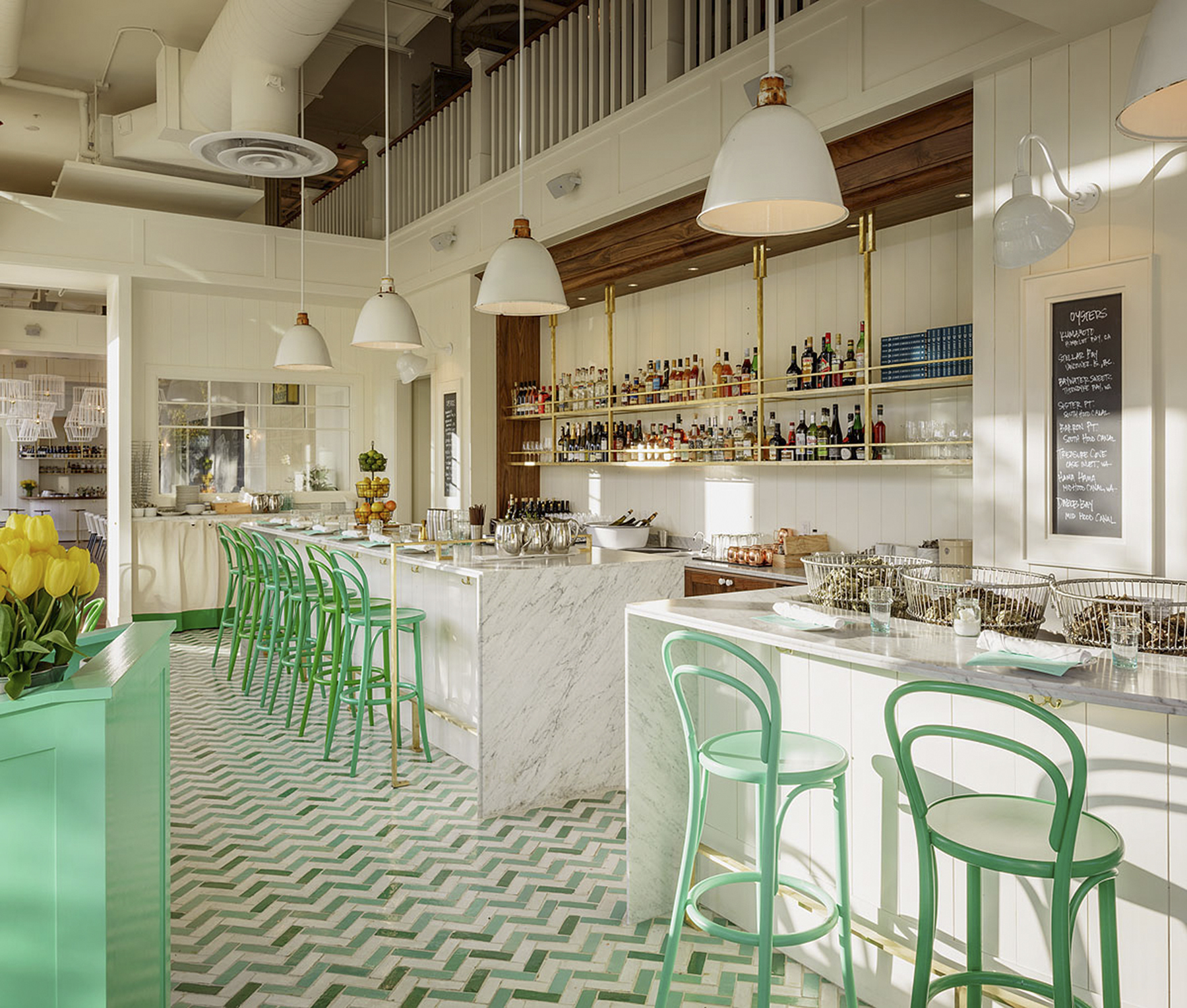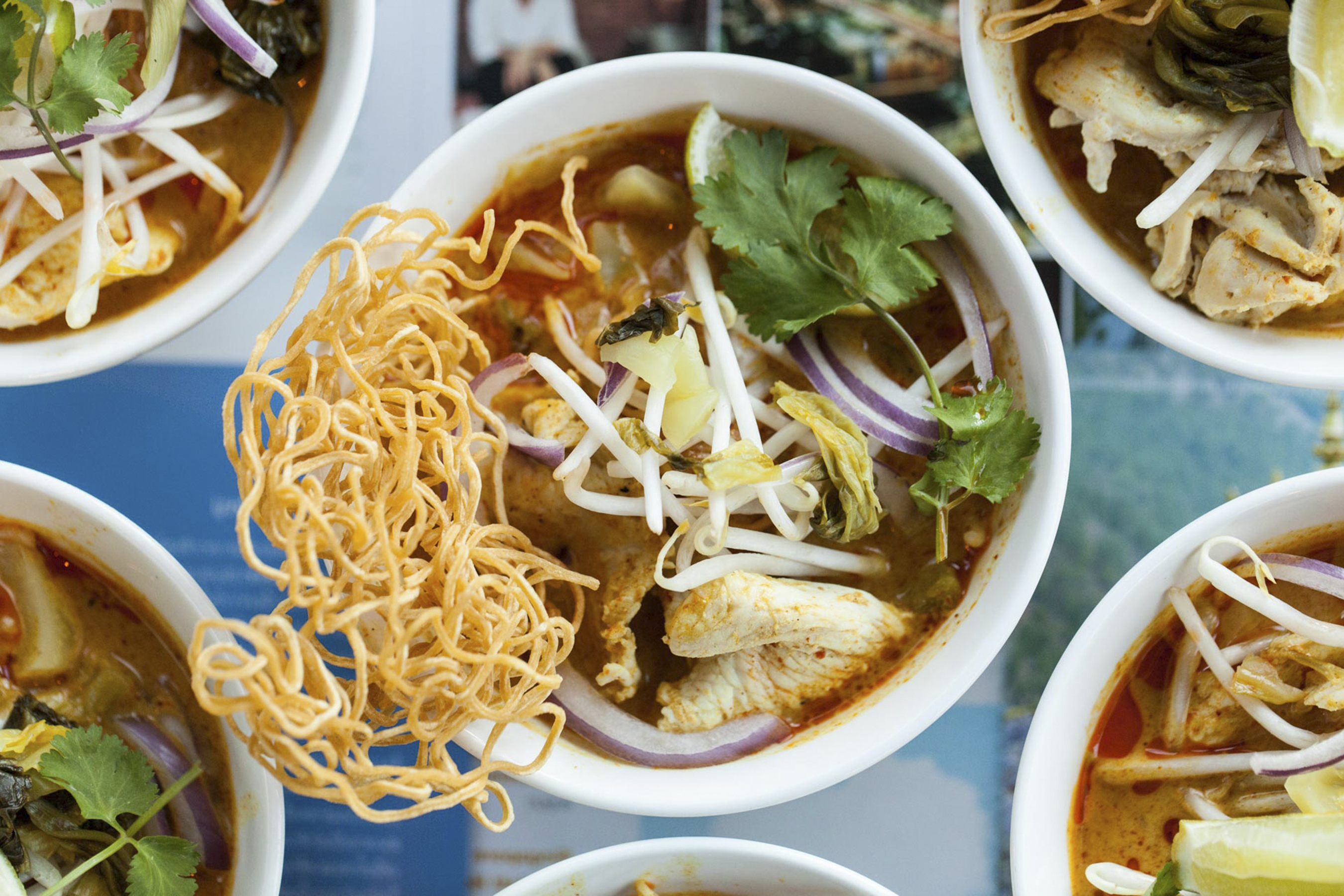We drive along Northlake Way, winding around the quiet north end of Lake Union, then brake suddenly in front of a mud-brown wooden cottage-like structure. A not-too-obvious sign indicates that this is indeed Westward. Out front, despite the cooler September air, people are dining on tables by the pier or sipping cocktails in Adirondack chairs beside a fire blazing in a pit fashioned out of oyster shells. I immediately get a good vibe. Wedged between the Seattle Marina and Sky Launch boat storage, Josh Henderson’s new seafood restaurant, which we previewed this summer, feels integral to the lake—not like the hulking special-occasion restaurants plopped garishly on an expanse of waterfront. It helps that it has a 150-foot dock, so that boaters can stop in to the restaurant’s accompanying grocery and oyster bar, Little Gull, to grab an oyster knife, a blanket, a charcuterie plate, or some oysters. This place belongs.
Inside it’s restrained, modern nautical chic, and I dig it. Big wooden beams resembling pilings separate tables from one another; round canvas lampshades with primary blue and red sailboat numerals hang from high ceilings; gold-framed oil paintings of ships in blustery seas and weathered sea captains line the walls. Fresh white paint throughout, as well as petite brown-leather-backed bar stools resembling boat seats, give it a classic oceanic feel. I appreciate the break from the de rigueur cold alliance of steel/concrete/wood that we’ve come to expect from our hippest restaurants. I also appreciate that while Westward is designed to beckon diners with its proximity to the lake, even the views are understated. Most every table gets to see some water, but there’s no sweeping view a la Aqua, which hopefully means you won’t find yourself dining next to wedding parties or large corporate gatherings.
The food, like the design, steers clear of pomp: no rich, unctuous sauces or special-occasion surf-&-turf combos. I don’t even see lobster, though there are some interesting “high-end” specials, like a smoked-trout caviar with creme fraiche at $23 an ounce (though from Brooklyn, mind you). It’s a very mild-flavored caviar, but one that really speaks of the trout. So mild, in fact, that serving it with potato chips seasoned with an Old Bay–like concoction seems an unbefitting choice. Not only do the chips overpower it, but it’s hard to balance tiny fish eggs on an incongruously shaped chip. A simple flat cracker would have worked better.
The pairing of expertly prepared dishes with accompaniments that don’t quite do them justice, in fact, becomes a recurring theme throughout my two dinners here. Clearly, Westward has chosen a Mediterranean-influenced menu—the wheelhouse of chef Zoi Antonitsas, formerly of Madison Park Conservatory. And when it works, it works beautifully, as in the halloumi cheese, served in big chunks rather than the usual thin, flat slices, accented with bite-size pieces of ripe watermelon and mint and fired up with urfa biber chili. Or a Moroccan fish stew, with a generous piece of rockfish, plump mussels, and cauliflower in a piquant, exquisite broth flavored with ras el hanout, a North African spice mix traditionally including, among others, cardamom, turmeric, peppers, ginger, nutmeg, and anise. It’s my favorite thing on the menu—that and the braised Oregon lamb shoulder, one of a handful of non-seafood options that proves to be fork-tender and is complemented with a tangy tzatziki sauce and an herb salad of parsley, mint, dill, and red onion so good that I made a batch at home.
But other dishes don’t come together as harmoniously, the Mediterranean elements often seemingly haphazard, garnish-like rather than cohesive additions. The gravlox, though good, got a little lost among its many delicious partners, including a beet puree blended down to caviar-like beads and a creamy labneh (a delicate, mellow kind of Greek yogurt) topped with spicy Mediterranean za’atar seeds. It’s a trend I noticed all summer in fashionable restaurants: the desire to get as many tastes—particularly seasonal ones—onto a plate, sometimes at the expense of what’s supposed to be highlighted.
Likewise the grilled mackerel, of which my first few forkfuls were amazing—until I hit the raw center. Mackerel is often served as sashimi at Japanese restaurants, but it’s not a fish designed to be undercooked. Our waiter whisked it away, said “We never make the same mistake twice,” and brought back a properly cooked one within 10 minutes, during which time we munched on our tasty tiny radishes with sea salt, parsley, and a goat-cheese dipping sauce.
They held true to their promise; this time the mackerel was cooked just right—and its slightly oily, fishy flesh was ideally paired with a sizable smear of charred, smoky eggplant. But the abundance of tahini on the side was a throwaway, its aggressive taste duking it out with the strong-flavored fish.
The whole branzino—we had the option to fillet it ourselves, which we did—was cooked faultlessly, but the decision to serve it with a side of avgolemono sauce was an interesting one. A frothy egg-lemon foam that our waiter likened to a light hollandaise, it provided the fish with a creamier mouthfeel and didn’t overpower the meat of its mild, white flesh. But it may have been just a tad too quiet. I appreciated the inclination to not overwhelm such a fish, but would have liked something that enlivened it a bit more. (What I did appreciate: the price point of a whole branzino at $28; this fish tends to be in the $30-and-up category.)
Westward is doing something different
with its menu. Our waiter tells us it’s designed for “feasting and sharing,” which means you won’t find conventional categories like appetizers and entrees. Instead, you’re supposed to tell the waiter how hungry you are and let him customize your choices accordingly. Potentially awkward, the interaction was made easy by a waitstaff that on both visits was earnest, attentive, and refreshingly comfortable expressing an opinion (one steered us away from the “Day Boat Octopus Bolognese” because “it’s not my favorite; the octopus is just ground into the sauce”).
On our first visit, we followed the suggestion to begin with a plate of raw oysters. The four available varieties that night—Kusshis, Kumamotos, Blue Pools, and Hama Hamas—all, according to our waiter, had a cucumber-lemon finish (I guess oysters get wine lingo now). My six were cold, slightly sweet, and good enough to skip the pink-peppercorn vinaigrette. The Blue Pools (from the Hood Canal), in particular, were small but meaty and sharp on the tongue; I wish I’d ordered just them. (David Leck, of Taylor Shellfish fame, is the oyster manager and promises that come October he’ll have 12 “cream of the crop” types to choose from: among them Virginicas and Olympias.)
Following the oysters, our waiter led us down a path of clean and light: gravlox over fried squash blossoms or potatoes cooked in the fire, the branzino over the fish stew. We went with it, but as the dishes came out, my friend and I both remarked that the recommendation was counterintuitive. Everything we’d ordered was fresh and mild; something with a little grease or fat would have been a more fitting counterpart. On our next visit, we took control and made sure to try the oyster roll (a twist on the East Coast lobster roll, served on a hot-dog bun but with tangy fried pickles) and the wood-baked gigante beans cooked in a tomato-and-feta mixture that had just the right amount of oiliness. Those small plates would definitely have made a great balance to the simply cooked branzino and raw oysters.
The drink menu here also endeavors to be unique. The wines herald from all over the world (even Greece), but I was surprised to find only one Washington red and white. I turned instead to the cocktail menu, which is particularly interesting for its tight curation: “Cocktails,” “Lighter Cocktails/Aperitifs,” “Beer Cocktails,” and “Seasonal Cocktails.” I chose a seasonal, the Picnic Basket, made with watermelon gin, strega, and spice bitters. My friend got the Nor’Wester: whiskey, forestry liqueur, and cocoa bitters. These folks know how to make a stiff drink that even my sea dog of a grandfather would approve of. All the “craft” cocktail condiments are there, but they’re not mucking up the spirit itself.
Dessert, as it admittedly so often does for me, disappointed. A chocolate olive-oil cake sounded mandatory, but had no discernible chocolate taste and was on the overly savory side, especially with the jarringly large grains of sea salt on top. The only sweetness on the plate was the brandied cherries, which, like a kid, I eagerly devoured. Likewise, the loukoumades (Greek donuts akin to zeppoles) were on the dry side, sweetened with too little of a tasty roasted-plum compote. Instead I indulged my sweet tooth from the “Lighter Cocktails/Aperitifs”: Dolin Extra-Dry & Rouge vermouth and orange. It was one of many good choices at a restaurant that’s shaping up to be one of Seattle’s seafood standouts.
nsprinkle@seattleweekly.com
WESTWARD 2501 N. Northlake Way, 552-8215, westwardseattle.com. 11:30 a.m.–10 p.m. Sun.– Thurs., 11:30 a.m.–10 p.m. Fri.–Sat. Happy hour 2:30–5:30 p.m. Mon.–Fri.









